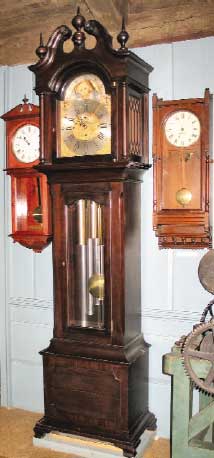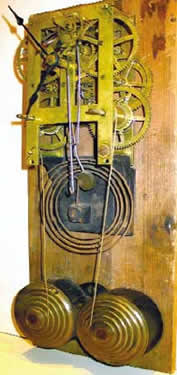Brass Is Best for Clocks
 Way back in the 14th century, iron was the first material used to make the movements of mechanical clocks. But, because iron rusts and is difficult to work with, corrosion-resistant brass, which is easily worked, became the preferred material by the 17th century. However, brass was expensive at that time, so many American clockmakers substituted then-plentiful hardwoods for brass.
Way back in the 14th century, iron was the first material used to make the movements of mechanical clocks. But, because iron rusts and is difficult to work with, corrosion-resistant brass, which is easily worked, became the preferred material by the 17th century. However, brass was expensive at that time, so many American clockmakers substituted then-plentiful hardwoods for brass.
As brass became more affordable and available in more-easily-worked forms, such as rolled instead of cast brass, it gradually displaced the wood in clock movements, according to Chris H. Bailey. He’s the curator of the American Clock and Watch Museum in Bristol, Connecticut, in the heart of what had once been the American horological industry. The museum contains several thousand clocks and watches, some dating back to the 17th century, according to Donald Muller, executive director.
Wood is of course inferior to brass in durability and especially so because it is so vulnerable to humidity (which is why clocks with wooden movements couldn’t be exported). But brass clocks cost about $50 each 200 years ago, which meant that only the well-to-do could afford them. Clocks with wooden movements sold for as little as $6 each, which the nation’s then largely agrarian population could afford. So what, if they were a few minutes off? For most farmers, absolute accuracy wasn’t essential! The last production clocks with wooden movements were made in 1848, just 10 years after the “cheap” brass clock was introduced by Chauncey Jerome.

An economic recession in 1837 had brought the clock business almost to a halt. Jerome, depressed about his business, was looking at a wooden clock one night. “It came to my mind instantly,” he writes, “that there could be a cheap, one-day brass clock–the case would cost no more, the dials, glass and weights and other fixtures would be the same, and the size could be reduced. I knew there was a fortune in it.”

The price of brass also dropped and its availability increased because the clockmakers cooperated in organizing companies to supply “clock brass,” said Bailey. The ready availability of thin, easily stamped sheets of brass, such as that supplied by the brass mill operated by Anson G. Phelps in Ansonia, Connecticut, was most helpful. (Ed. Note: The mill, founded in 1834, was the forerunner of what is now the Phelps Dodge Corporation in Phoenix, Arizona.)
As a result, many other brass fabricators came to New England. In particular, they made mechanical toys that used rudimentary, wind-up clock movements to move parts of the toys and propel them, as well as buttons, lamp burners, flatware, kettles and many other brass products. There was no one “clock brass,” because much was made from scrap materials, and some suppliers added antimony and other metals to soften the brass to make it easier to work.
Early Mass Production
 Thomas Jefferson designed this weight-energized clock with brass movement for the entrance hall of his Virginia home, Monticello. The ropes extending left and right of the clock are attached to suspended weights on the side walls. A wire emerging from the top connects to the clock’s striking mechanism. Replicas can be purchased by calling 800-243-1743.
Thomas Jefferson designed this weight-energized clock with brass movement for the entrance hall of his Virginia home, Monticello. The ropes extending left and right of the clock are attached to suspended weights on the side walls. A wire emerging from the top connects to the clock’s striking mechanism. Replicas can be purchased by calling 800-243-1743.American Clock Museum: 860-583-6070
Photo by Monticello/Thomas Jefferson Foundation, Inc.
Mass production was another way to lower the price of clocks with brass movements, which steadily dropped in price down to as little as $1.50 by 1880. Instead of individual workers making all the parts of movements, a time-consuming process, Eli Terry set up a factory in which many workers specialized in just one part each. In addition, improved jigs and tools were introduced. As a result, production zoomed to hundreds of movements a day. And, according to Bailey, the parts were interchangeable — unlike those in rifles made by Eli Whitney, who is wrongly credited as the first American to achieve interchangeability of parts.
Another way to lower costs was to make clock cases smaller, especially by energizing the movements with compact brass springs instead of weights at the ends of long cords. As movements shrank in size, it became possible to create smaller, less expensive clocks and even wearable watches. The first inexpensive, nonjeweled fob watches were introduced in 1877. Before long, they became known as “dollar” watches, though many cost a bit more than a dollar. Some of the first ones were the size of hockey pucks and could easily wear a hole in a man’s pocket.
Ingenious watchmakers soon shrank the size of fob watches, resulting in the introduction of wrist watches for women in 1907 by Elgin and Waltham. Synchronous electric clocks came next, in the late 1920s. During World War II when brass was needed for ammunition, manufacturers were forced to make the cases for alarm clocks out of papiermâché. These “war alarm” clocks sold for only $1.69 each. Ultimately, the American horological industry fell victim to foreign competition. But the legacy of Connecticut’s “brass valley” clock companies remains on view at the American Clock and Watch Museum.

“Atomic” Accuracy Requires Pure Copper
 This precision-machined (+/- 0.003 inch) copper cylinder helps fine-tune a TeflonTM–coated quartz bulb where atoms produce the extremely high frequency that controls the clock’s timing.
This precision-machined (+/- 0.003 inch) copper cylinder helps fine-tune a TeflonTM–coated quartz bulb where atoms produce the extremely high frequency that controls the clock’s timing.Afive-pound cylinder of ultra-pure copper 12 inches long is a key element in a super-accurate “atomic” clock from Symmetricom, Tuscaloosa, Alabama. In contrast to the best colonial-era clocks with brass movements, which could be up to several minutes off, these clocks are accurate to one part in a trillion, according to Bryan Owings, a company manager.
Among those requiring such high accuracy are the U.S. Naval Observatory, Washington, D.C., which keeps time for the entire nation, and the Global Positioning System, Colorado Springs, Colorado. High accuracy is costly, close to $300,000 per device. The pure copper cylinders are supplied by (Waukesha) Wisconsin Centrifugal.
Symmetricom: 205-553-0038
Wisconsin Centrifugal: 262-544-7777
Also in this Issue:
- From Spools to Jewels
- Model Home Inspires Nation’s Builders
- Brass Is Best for Clocks
- Bells Are Ringing
